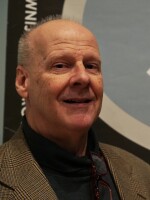The NIU Art Museum’s current exhibition explores aspects of war -- before, during and after. The subject is personalfor some of the artists.
Peter Olson, assistant director of the NIU Art Museum, showed me a room filled with photographs. Arranged in groups of three, the larger-than-life closeups of young men -- British soldiers who had been deployed to Afghanistan -- stare straight out at you.
“These are portraits of the same person before combat during combat and after combat," he said. "And you can see that sometimes you can see a dramatic change in their faces.”
In a way, he said, they are a memorial -- not to someone dead, but to an earlier self, pre-combat, who no longer exists. That’s true of the next piece too.
Large upright wooden beams like sentinels surround a glass case holding a set of battered, worn boots. Olson said they belong to the artist, a veteran of many years of combat.
“And so in a sense," he said, "this, too, is a portrait, even though it's not a traditional portrait, like an oil painting of a person's bust or something like that. And it's very much about his experience, but also sort of universal.”
In the next room, a swirling sculpture -- like a huge bird’s nest -- made up of plywood guns covered with allusions to Bosnia and Columbine that Olson said is a comment on not just war, but gun culture in general.
A set of what looks to be family portraits here are a bit surreal. Why does each one include someone wearing an odd, even disturbing, mask? Stuart Henn is Marketing and Education Coordinator for the Museum. He said the masks worn by the veterans in the pictures were created by them in a workshop.
“Where they were able to non-verbally express things that they can't express verbally," he said, "and wear visibly on the outside the things that they're carrying with them on the inside.”
Then there’s a ceramic piece -- an American flag made like a jigsaw puzzle. Six of the pieces have fallen out of it. Olson said the artist was deployed in Iraq, and the six represent people in the artist’s platoon -- three who died in combat, three who committed suicide after their return to the U.S.
“That's something we can all sort of think about," he said. "The implications of combat. That it's not just about what happens during an actual combat situation, but what is life like afterwards?”
In contrast, a nearby sculpture makes you smile when you realize what it is: a crab, made out motorcycle chain, a wrench and bolts. Olson said the artist, a combat veteran who was trained to do metal working while in the service, suffered from post traumatic stress syndrome afterwards.
“And he actually found," Olson said, "that he could use the skills that he had learned in the military, this metal working, to make sort of like found-object kind of whimsical sculptures. The experience that caused his trauma was also the key to his healing.”

But look up from the crab and you are confronted by a huge painting -- bright, almost harsh colors, wild shapes -- are those tentacles? The title contains a clue – a reference to the Roman God of War. It’s unsettling. How much, Olson said, depends on the individual.
“I've never been in a combat situation," he said. "So I can't say this is what it feels like. But that is what other people have said about this piece. And I just find it to be very, very arresting kind of experience to just stand in front of it.”
There are other pieces here. Some pretty clear -- or at least seeming so. Some not clear at all. And most sending mixed, often very personal, messages.
Stuart Henn said the artists in this showdemonstrate the power of the medium to express such a vast subject as "war" on a human scale.
“I think the interesting thing about the visual arts," he said, "is that they help us grapple with complex issues. It's not just about patriotism, it's not just about protest, but it's both/and.”
And, Peter Olson said, if that leaves people with more questions than answers, well, when it comes to something like war, maybe that’s not such a bad thing.








